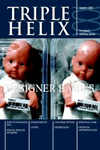This book consists of 22 papers by historians, legal and political theorists, medical practitioners, pastors, philosophers and theologians, delivered at the International Conference on 'The Great Jubilee and the Culture of Life' held at Queen's College, Cambridge in July 2000. This was organised for Roman Catholics with an active interest in healthcare ethics in response to Pope John Paul II's invitation to celebrate the year 2000.
Luke Gormally, Director of the Linacre Centre for Healthcare Ethics, a Catholic thinktank, explains that this book deals with the 'Clash of orthodoxies' - contemporary liberal secularism versus Judaeo-Christian moral tradition, two cultures with deeply opposed understandings of human life. The cover picture, Gernt van Honthorst's Christ before the High Priest, symbolises the confrontation between the culture of death and the culture of life. It was Caiaphas, the High Priest, who uttered the prototypical consequentialist judgement, 'You do not realise that it is better for you that one man die for the people than the whole nation perish.' (John 11:50). Willingness to sacrifice the innocent for 'the greater good' is central to the philosophy of the culture of death. However there was prophetic truth in Caiaphas' words beyond their intended meaning. Christ's redeeming death brought a message of life and hope to the world. The ultimate source of the culture of life is our Lord Jesus in his life, death and resurrection.
Cardinal Winning's opening address identifies characteristic manifestations of the culture of death: abortion, embryo experimentation and imperialist imposition of contraception and abortion policies on developing countries. The root of this culture is 'the eclipse of the sense of God and man'. Among four chapters on the culture of death, is a fascinating one about the de-Christianising of England. This one traces the evolution of secular philosophy that has profoundly influenced contemporary medical ethics eg from key thinkers such as JS Mill. In her report on Human Fertilisation and Embryology in 1984, Baroness Warnock appeals to Mill for her justification of relativism. Chapters on the culture of life deal with its theology, promotion, politics and medicine in the developing world. Examples of Christian initiatives bringing hope to destitute mothers, combating the spread of AIDS and caring for AIDS victims are eloquently described. Supplementary papers deal with eugenic genetic engineering, stem cell research, contraception and 'quality of life' ethics.
This Roman Catholic publication inevitably refers to classic papal encyclicals and traditional Roman doctrines without scriptural foundation such as the ban on 'artificial' contraception, the celibacy of priests, the 'sacrifice' of the Mass and human suffering sharing in the redemption accomplished by Christ. Some of these will appear to evangelicals to detract from the glory and uniqueness of Christ's atoning work. Nevertheless, read with discernment, there is much here that is valuable, thought provoking and consistent with a true biblical medical ethic, to interest, stimulate and challenge the Christian doctor.
Reviewed byStephen Browne
GP Principal in Birmingham































